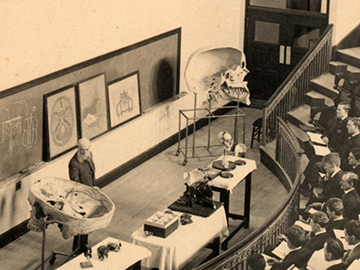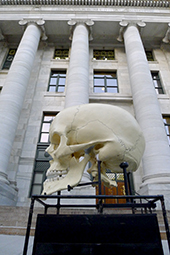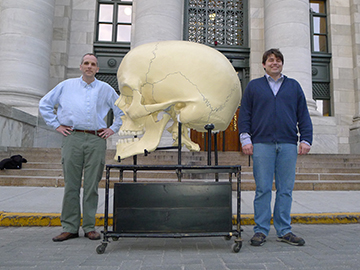Head of the Class
Head of the Class
Giant skull and foot models donated to Warren Anatomical Museum
 Thomas Dwight lectures to medical students in 1906 using two skull models. The one at right has just been donated to the Warren Anatomical Museum, while the one at left is still used today in the teaching of anatomy. Image: Photograph Collection, Harvard Medical Library in the Francis A. Countway Library of Medicine
Thomas Dwight lectures to medical students in 1906 using two skull models. The one at right has just been donated to the Warren Anatomical Museum, while the one at left is still used today in the teaching of anatomy. Image: Photograph Collection, Harvard Medical Library in the Francis A. Countway Library of Medicine
When Thomas Dwight became Parkman Professor of Anatomy at Harvard Medical School in 1883, succeeding Oliver Wendell Holmes, he had big shoes to fill. Fortunately, he ordered the construction of a 48-inch-long skeleton of a foot to use as a visual aid during anatomy lessons.
After more than a century of classroom use, the foot, along with a 78-inch-tall model of a bisected human skull also commissioned by Dwight, has reached the age of retirement. They have been donated to the Warren Anatomical Museum at the Francis A. Countway Library of Medicine.

People waiting for an elevator in Building C or walking down Shattuck Street by Gordon Hall late Friday afternoon were treated to the sight of staff members carefully wheeling first the foot and then the giant skull from the HMS Department of Anatomy to the Countway basement.
Together with other striking depictions and preserved specimens of the human body from the last 500 years, the models will soon be loaned to the Collection of Historical Scientific Instruments at Harvard University for a public exhibit on the history of human anatomy.
“These were incredible, dynamic education tools, and they should serve as dramatic pieces in what promises to be a powerful exhibit,” said Dominic Hall, curator of the Warren Museum. “Afterwards, we’re hoping we can find a display home for them at the Countway for students’ continued interest and reference.”
Anatomy of an exhibit
Scheduled to run from March through December 2014, the university exhibit will focus on the multifaceted nature of human anatomy, including its roles in scientific discovery, public spectacle and medical education. (A companion exhibit will run concurrently at the Countway.)
Items will range from the “spectacular” illustrated texts the famous anatomist Andreas Vesalius created during the Renaissance to the wax-injected limbs and dissection labs of the 19th century to the lifelike digital atlases of today, said David S. Jones, the A. Bernard Ackerman Professor of the Culture of Medicine at Harvard and one of the co-organizers of the upcoming exhibit.
In collaborating with various participating institutions to shape the exhibit, including the Center for the History of Medicine at the Countway and the Harvard Museums of Science and Culture, Jones quickly came to appreciate that “our strength is the anatomical collections. I’ve done a fair amount of teaching on the history of anatomy and even I had no idea the fascinating specimens the medical school has in storage,” he said. “It’s been great to bring some of this out into the light of day.”
Literally, in the case of the newly donated models.

David S. Jones (left) and Dominic Hall (right) take a break with the giant skull in front of Gordon Hall. Image: Jake Miller
A second skull commissioned by Dwight in 1892, this one sliced in half horizontally rather than vertically to show different anatomical structures, was not donated because it is still being used to teach.
The anatomy department did lend several other items to the exhibitors in addition to the foot and skull, including a classic classroom skeleton on wheels and a set of human body cross-sections preserved in Lucite blocks.
“The anatomy department at HMS has been wonderful in providing not only materials but also historical perspective and a narrative in which to place them,” said Hall.
“Once we make our final decisions about which specimens to display, the exhibit designers will develop the plan for the show,” said Jones. “Then our task will be to get the text right.”
Delicate balance
That’s no easy feat, given the controversies that have surrounded the study of human anatomy across centuries.
As time passed, body snatching, murders and riots slowly transformed into voluntary anatomical gift programs. Legal frameworks took shape around the practice of dissection. Technologies for depicting body structures progressed from furtive sketches to digital reproductions of such high quality that they are stimulating debate about the value of continuing to use cadavers in medical education.
“We have to strike the proper balance between the respect that is owed to these specimens and discussing the fact that such respect is a recent development,” said Jones. “We want to capture all these social, legal, technological and educational tensions.”
“It’s an exceptionally complicated historical subject—grave robbing on one end and expanding human health on the other,” added Hall. “We need to be incredibly thoughtful as we sort through the narrative.”
The exhibit organizers expect they will have the advantage of inherent public interest.
“Everyone’s so curious. We’re human and we want to know about ourselves,” said Jones.
“One of the challenges is that even the best preserved specimens are a pale reflection of a living body,” he added. “Living tissue is so much more vibrant and dynamic. The organs glisten in rich colors, the arteries pulse … the human body is amazing. I hope visitors come away from the exhibit with the same appreciation.”
By STEPHANIE DUTCHEN
###
About Harvard Medical School (HMS)
Driving Change. Building Momentum. Making History.
“Since 1872, Harvard Medical School has been the incubator of bold ideas—a place where extraordinary people advance education, science and health care with unrelenting passion.
Whether training tomorrow’s doctors and scientists, decoding the fundamental nature of life, advancing patient care or improving health delivery systems around the world, we are never at rest. Allied with some of the world’s best hospitals, research institutes and a University synonymous with excellence, the School’s mission remains as ambitious as it is honorable: to alleviate human suffering caused by disease.”
More at Harvard Medical School & Harvard Medical School. Generations of Leaders.
_________________________________________________
###
About Harvard School of Public Health (HSPH)
Harvard School of Public Health is dedicated to advancing the public’s health through learning, discovery and communication. More than 400 faculty members are engaged in teaching and training the 1,000-plus student body in a broad spectrum of disciplines crucial to the health and well being of individuals and populations around the world. Programs and projects range from the molecular biology of AIDS vaccines to the epidemiology of cancer; from risk analysis to violence prevention; from maternal and children’s health to quality of care measurement; from health care management to international health and human rights.
More at Harvard School of Public Health (HSPH) & Harvard School of Public Health (HSPH). History.
_________________________________________________
###
About Harvard University.
Established in 1636, Harvard is the oldest institution of higher education in the United States. The University, which is based in Cambridge and Boston, Massachusetts, has an enrollment of over 20,000 degree candidates, including undergraduate, graduate, and professional students. Harvard has more than 360,000 alumni around the world.
Harvard University is devoted to excellence in teaching, learning, and research, and to developing leaders in many disciplines who make a difference globally. Harvard faculty are engaged with teaching and research to push the boundaries of human knowledge. For students who are excited to investigate the biggest issues of the 21st century, Harvard offers an unparalleled student experience and a generous financial aid program, with over $160 million awarded to more than 60% of our undergraduate students. The University has twelve degree-granting Schools in addition to the Radcliffe Institute for Advanced Study, offering a truly global education.
‘Universities nurture the hopes of the world: in solving challenges that cross borders; in unlocking and harnessing new knowledge; in building cultural and political understanding; and in modeling environments that promote dialogue and debate… The ideal and breadth of liberal education that embraces the humanities and arts as well as the social and natural sciences is at the core of Harvard’s philosophy. ’/ Drew Gilpin Faust
More About Harvard University & About Harvard University. Information.
###
* The above story is adapted from materials provided by Harvard University
_________________________________________________________________























